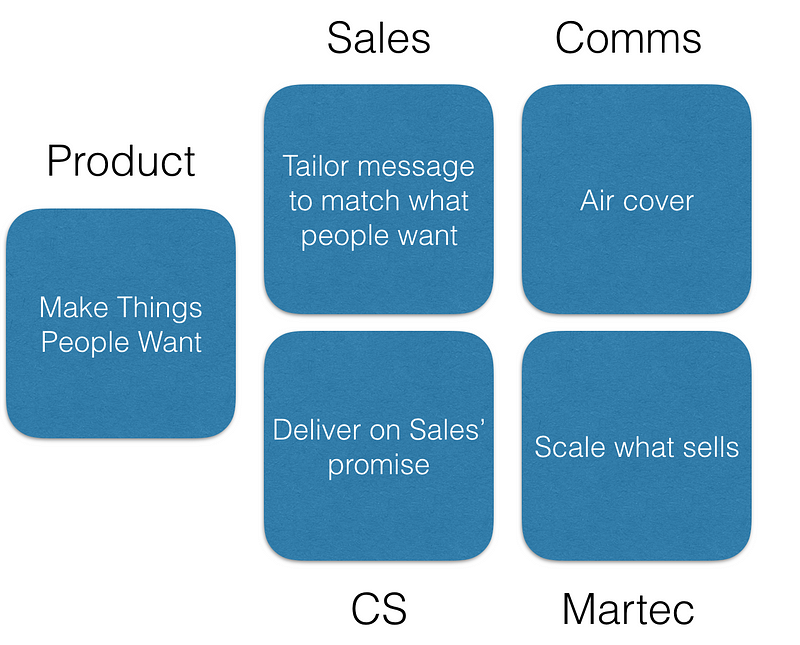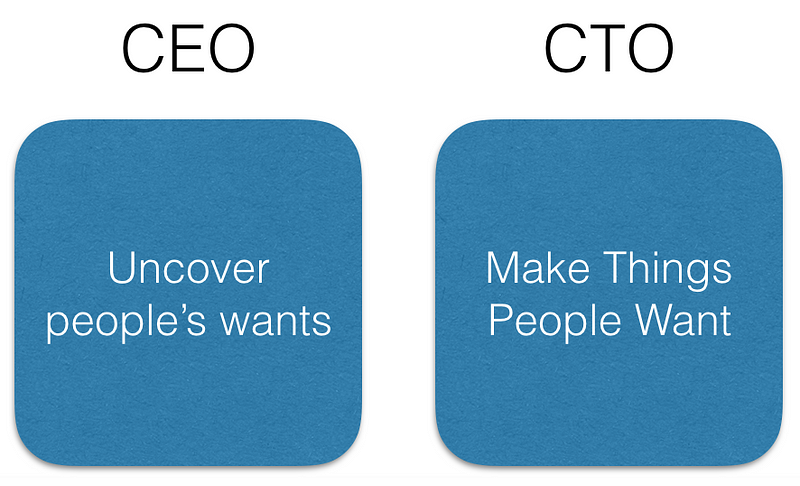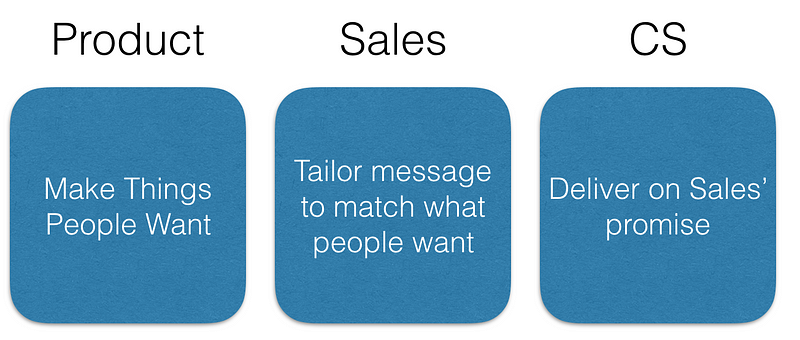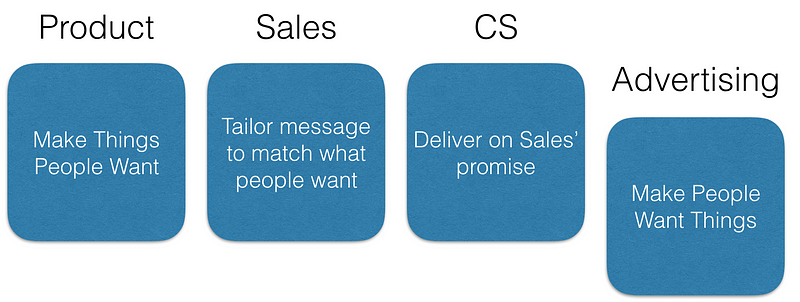How to align sales and marketing
Marketers: your company struggles with sales-marketing alignment. It is not your fault. In this essay I’ll explain how to finally align…


Marketers: your company struggles with sales-marketing alignment. It is not your fault. In this essay I’ll explain how to finally align your organization.
First, some history: in the past century marketing has been radically transformed, but the art of selling hasn’t really changed: the best salespeople still uncover each prospect’s desires and then tailor the product to these desires. And they keep going:
“Our greatest weakness lies in giving up. The most certain way to succeed is always to try just one more time.” — Thomas Edison
How has marketing changed?
In the beginning there was only one medium: print ads. All of the innovation went into messaging. When the mediums expanded to TV and radio, you still had a finite set of places to advertise and the magic was in the message.
This was true for a century. Think about it: how else can you innovate in marketing when your only channels are TV radio and print? You can’t.
Then the mediums exploded. In their book Traction, Gabriel Weinberg and Justin Mares cite 19 different mediums. Why 19? Where’s Snapchat, Instagram, Ning, G2Crowd, Spiceworks, etc.?
I asked Mares and he said something like the following:
Our last (medium), existing platforms, covers all of these new platforms coming out.
If they had written Traction to truly cover every medium, they never could have finished.
So now we have as marketers this overwhelming amount of choice. With hundreds of mediums, you’ll never run enough A/B tests to succeed, except by accident.
Meanwhile, in parallel, the number of marketing mechanisms exploded. What is a marketing mechanism? It is a repeatable tactic that applies within a medium to get your marketing working.
In just one medium, email, there are an overwhelming number of mechanism options you have to choose:
- What day should I send? Is it relative to buying cycle or absolute?
- What day of week should I send?
- What time of day should I send?
- Should I personalize the subject line? First name, last name, or both?
- Should I address the prospect by name?
- Should I send from a marketing alias or a real person?
- Should I use a text-based email or a nicely designed HTML email?
- Should the message be short or long?
- Do I include links? How many?
- Do I ask for a reply?
- Do I include attachments? How many?
- How many emails should I send?
- Do I include an unsubscribe footer?
- Do I send from my ESP or through our corporate server/G Suite?
- What signature do I use?
With just those 15 choices above, there are more than 32,000 possible emails you could send, each with the same message and medium.
With so many options, most marketers feel spoiled for choice. When a new technology or blog post emerges with best practices, we quickly try to adopt these, just so we have less decisions to make.
When to send emails? “10am Tuesday, that’s what Hubspot said!”
Do we include links? “Yes but only one, thats what Copyblogger said!”
What about the unsubscribe link? “Oh yeah include that too, that’s what our lawyer said!”
And then that collection of messages, mediums, and mechanisms fails to deliver pipeline. It turns out in the last 100 years, marketing hasn’t changed much after all:
Half the money I spend on advertising is wasted; the trouble is I don’t know which half.— John Wanamaker
Despite these challenges, there are companies who succeed to align sales and marketing.
The secret is in understanding the real jobs of sales and marketers (and product and customer success).
Most startups begin with only product and sales, some form of the duo CEO and CTO.

In B2B, the company then typically grows by adding customer success:

So far so good: you’ve identified what people want, you’ve made for them, and your Sales and CS teams have found alignment,
But you want to grow faster, so you hire marketing. The trouble is, traditional marketers think a bit… different.

Wait, you thought you hired Marketing, so why does that say Advertising?
Most degrees in marketing amount to a degree in the history of advertising.
While the professions of product, sales, and customer success all align around the worldview of the customer, the profession of advertising is all about changing the worldview of the customer.
This mission, to make people want things, is why you find yourself paying for new logos twice in five years. It is why your marketers want to produce a viral Youtube video about your compliance service. It is why your marketers think NPR is a great marketing channel for your niche product.
And this used to work: women started smoking cigarettes in the US because of one clever PR campaign. Many of the concepts in Mad Men actually happened.
You can make people want things, but with so many mediums you have to validate what is working: that after all is the thesis of the book Traction.
So your org might adapt by thinking of marketing this way:

Great, at least now marketing is not just advertising. This combination, “make people want things” and “test everything” sounds like a great approach, until you consider the permutations: hundreds of mediums; over 32,000 possible versions of just one email with one message; infinite messages.
Your marketers simply cannot test everything, so they will instead default back to making pretty logos and trade show booths.
I promised at the beginning I would show you how to align your organization. It turns out you can’t align sales and advertising: they want different things. And you can’t quite align sales with testing: as long as marketers think they can test their way to an effective combination of the billions of possible mediums messages and mechanisms, they will be unable to support the things that made your company grow in the first place.
But you can align your organization. The key is to rethink what you actually need. It turns out you don’t need to test every medium and mechanism: you can get much further simply by repeating what works for the Sales and CS teams.

The key to growth: scale what sells.
What does it mean to scale what sells?
It means actually analyzing sales calls to find the words buyers use, instead of hiring a copywriter from Mars to make something clever. It means writing a press release for every product before developers start building it, and drafting a case study for every customer as soon as they sign the first contract. It means actually going on sales calls, if that will teach you something new about customers.
Scaling the successes means you don’t send a single email campaign until you understand every email your sales team has already sent. It means you don’t score leads on some authoritarian high modernist view of digital body language, but instead interview everyone involved to uncover the real attributes that lead to a purchase — even if you can’t source the data for these attributes yet.
There is still some room for traditional marketing: many innovations will come from marketers who can identify whats missing in your approach, that thing your sales team would never try that only works at scale.
But unless you have an Uber-sized budget to dominate a market, unless you’re in a category where the only move left is to innovate in advertising, your best bet for alignment is to stop trying to change world views, and start scaling successes.